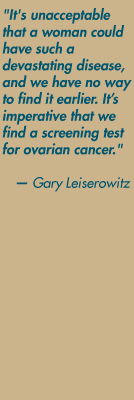Researchers are determined to find a screening test
for ovarian cancer, and new treatments for the disease
They call it the disease that whispers. Ovarian cancer doesn't announce itself with obvious signs. Its early symptoms are so subtle and nonspecific that two-thirds of women with the illness aren't diagnosed until they have advanced disease.
Jennifer Whitney's experience was all too typical.
When the Folsom mother of two began having vague gastrointestinal complaints early last year, she consulted her primary care doctor. As her discomfort worsened, he ordered first a colonoscopy, then a pelvic ultrasound.
The colonoscopy was normal. The ultrasound wasn't: Both ovaries appeared grossly enlarged.
Whitney was referred to Gary Leiserowitz, chief of gynecologic oncology at UC Davis Cancer Center. Surgery was scheduled. The 39-year-old woman wouldn't know until afterward whether she had cancer or a benign problem, such as ovarian cysts.
Whitney's husband, Brian, gave her the news in the recovery room. It was cancer.
When ovarian cancer is diagnosed at the earliest stage, stage 1-A, the five-year disease-free survival rate is about 90
percent — meaning about nine in 10 patients will be alive in five years with no evidence of disease.
Whitney's cancer, which had spread to her abdomen, was stage III-C. For women with this stage of the illness,
the five-year disease-free survival rate is 25 to 30 percent.
"It's unacceptable," Leiserowitz says, "that a woman could have such a devastating disease, and we have no way to find it earlier. It's imperative that we find a screening test for ovarian cancer."
Says Sidney Scudder, Whitney's hematologist-oncologist: "If we had the same kind of early detection tools available for ovarian cancer that we have for cancers like breast cancer, we could expect the same survival — 85 to 95 percent at stage I." With patients like Whitney never far from their thoughts, UC Davis Cancer Center investigators are working hard to develop such tools — as well as new, more effective treatments for advanced disease.
One potential screening tool has shown particular promise in early testing. Cancer center researchers including Kit Lam, professor and chief of hematology and oncology, Suzanne Miyamoto, a research biochemist, and Leiserowitz are collaborating on the project with Carlito Lebrilla, a professor of chemistry on the Davis campus.
The investigators have developed a technique to identify changes in bloodstream sugars that appear to be characteristic of ovarian cancer. The team has used the technique to test blood samples from 24 women with confirmed ovarian cancer and 24 healthy women. "So far it's been highly accurate," Lebrilla says. The blood test is in preliminary investigation, but the researchers are hopeful the approach could lead to a test that would allow doctors to detect ovarian cancer early, when it is most curable. Women like Whitney — who faithfully gets her mammogram and Pap smear every year — potentially would add one more test, a blood test for ovarian cancer, to the annual exam.
There is one commercial blood test available for ovarian cancer, but it is too unreliable for screening. That test, which measures levels of a tumor marker known as CA-125, is no more accurate than a coin toss when it comes to detecting early ovarian cancer. CA-125 testing is currently used for monitoring treatment response and disease recurrence in ovarian cancer patients.
Better treatments
Lam is also working on better treatments for ovarian cancer. He has discovered one compound that may double as both a detection method and a treatment for ovarian cancer. He developed the compound using combinatorial chemistry, a high-tech science that allows researchers to rapidly create and test potentially therapeutic new molecules en masse.
In early testing, Lam's new compound binds to ovarian cancer cells but not to any other cells. He hopes the compound will be useful for tagging ovarian cancer cells for diagnosis, or for delivering drugs directly to cancer cells.
Several antibody-based anti-cancer agents, which work in much the same way, are already on the market. Examples include Herceptin, which binds to breast cancer cells, and Zevalin, which attaches to lymphoma cells.
Lam's compound is much smaller than an antibody, however — and therefore may be more successful than current molecularly targeted agents at penetrating deep inside tumors. No currently available agent specifically targets ovarian cancer cells.
Clinical trials
Meanwhile, five other new treatment approaches for ovarian cancer are available through clinical trials at UC Davis Cancer Center. Leiserowitz is the principal investigator of two of the trials. David Gandara, professor of hematology and oncology and the cancer center's associate director of clinical research, heads the others.
These investigational therapies mean more options for patients with advanced ovarian cancer than ever
before. Increasingly, ovarian cancer is becoming a chronic disease — one that can be controlled for
many years through a succession of treatments.
Mid-way through her chemotherapy, wearing a soft periwinkle cap, Whitney is ready to get back to her
normal activities — cheering for the boys at Folsom Junior Bulldogs games, enjoying the family's
new backyard pool and taking occasional weekend camping trips.
"I want to be done and move on with my life," she says.
Whitney's doctors want the same for her — and better chances for every woman with ovarian cancer.




